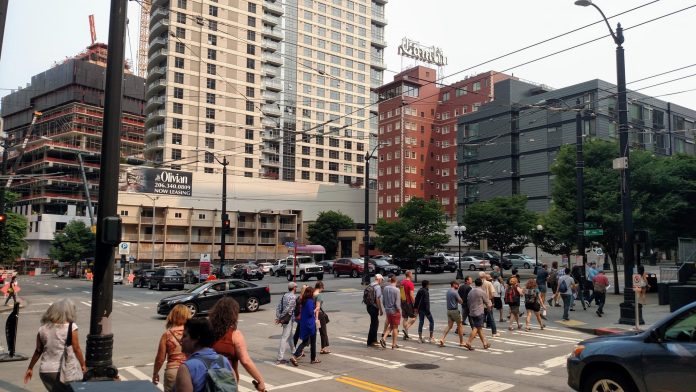Seattle has ambitious plans for 2018.
Taking MHA Citywide… Can We Expand It to Single Family?
The Seattle City Council plans to expand the Mandatory Housing Affordability (MHA) program taking inclusionary zoning citywide, at least in land zoned multifamily and commercial. That the MHA program wouldn’t apply to single-family zones is yet another reason to rezone them too. Single-family zones could get a bit more flexibility in 2018 if Mike O’Brien’s accessory dwelling unit (ADU) bill is enacted as planned after the delay caused by the lawsuit forcing a full Environmental Impact Statement. Many urbanists would like to go further to expand urban village boundaries, add new urban villages, and/or eliminate single-family zoning entirely.
Out-Organizing NIMBYs
Housing advocates scored a cathartic victory to start 2018 when they turned out in droves and greatly outnumbered opponents at a public meeting on Seattle Office of Housing’s plan to develop 238 affordable homes at Fort Lawton. The “Yes In My Backyard” movement picked up steam in 2017, and the Fort Lawton meeting was an exclamation point. (Of course, Fort Lawton isn’t a done deal yet.) Can housing advocates build on that success to prevent other projects from being blocked or delayed by noisy opposition? Will policymakers give advocates more opportunities by upzoning more sacrosanct million-dollar home territory? Will developers see a changing landscape and propose projects they would have thought too risky before? It’d be great to see affordable housing projects go in other wealthy enclaves that have mostly blocked them one way or another–neighborhoods like Montlake, Madison Park, Laurelhurst, Upper Queen Anne, Seward Park, and anything west of Fauntleroy Way in West Seattle, as you can see in the map below.

Olympia Wants to Slash Car Tab Fees as Transit Advocates Rally to Save ST3 Funds
We’ve been closely monitoring bills seeking to cut Sound Transit 3 (ST3) funding by reducing the Motor Vehicle Excise Tax (MVET). Thanks to your pressure, Democratic legislators are rethinking HB 2201, which would have cut approximately $2.3 billion from Sound Transit’s budget without replacing it. Now it seems like Democrats are realizing they should replace lost funds if they want to go through with cutting car tab fees. Let’s keep the pressure on and if anything move Sound Transit’s timelines up rather than backwards.
Planning ST3 Alignments
2018 will be a big year for planning ST3 light rail alignments–and possibly the last chance to get the plan switched to a Salmon Bay tunnel (or a fixed high bridge) from a movable bridge that could cause delays while it opens for tall ships. The City of Seattle and Sound Transit are hoping that quickly settling on preferred rail alignments for Ballard and West Seattle will help deliver the projects ahead of schedule, and they’re setting up advisory groups to which you can apply. This could shave a few years off West Seattle’s 2030 expected opening and Ballard’s 2035 target. To get the projects much earlier would likely require finding a new source of funding (e.g., more bonding) so that Sound Transit could bid out big ticket items sooner. Urbanists should be pushing for that, too.
Democratic Majorities in State Legislature Could Mean Climate Action
With Manka Dhingra’s resounding victory in the 45th Legislative District, Democrats claimed a one-seat majority in the state senate. Democratic control of the legislature and the executive branch has raised hopes that major action on climate change is imminent. Governor Jay Inslee proposed carbon tax legislation and, with your help, it has a pretty good chance of passing. The governor’s bill would charge $20 per ton of carbon emissions, with exceptions for the aviation industry, some agricultural uses, and others. Half of the revenue would be invested in electrification of our transportation sector, which would mean capital improvements for transit or potentially fund high speed rail. Some legislators have proposed their own climate change legislation, including HB 2338 spearheaded by Representative Joe Fitzgibbon.
Period of Maximum Constraint
Seattle Transit Blog has a good rundown of the projects slated to start in 2018, and Mike Lindblom covered the “period of maximum constraint” in the next few years with a slew of construction projects: the Alaska Way Viaduct will come down, dozens of towers will go up, and Washington State Convention Center Addition construction and Northgate Link testing will lead the Downtown Seattle Transit Tunnel to be closed to buses likely in September 2019. This unfortunate convergence of disruptions also comes with the opportunity to press for multimodal improvements like a Basic Bike Network and more dedicated bus lanes, which was the promise of One Center City. It will fall upon urbanists to makes sure One Center City isn’t watered down. Additionally, the Washington State Department of Transportation (WSDOT) plans to repave Aurora Avenue from Roy St northward starting in the spring, which would provide further disruption. WSDOT promises to rebuild pedestrian ramps to improve pedestrian access along the SR-99 car sewer.
Doug Trumm is publisher of The Urbanist. An Urbanist writer since 2015, he dreams of pedestrian streets, bus lanes, and a mass-timber building spree to end our housing crisis. He graduated from the Evans School of Public Policy and Governance at the University of Washington in 2019. He lives in Seattle's Fremont neighborhood and loves to explore the city by foot and by bike.


